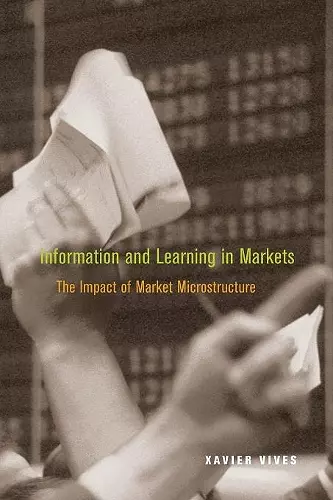Information and Learning in Markets
The Impact of Market Microstructure
Format:Paperback
Publisher:Princeton University Press
Published:2nd Mar '10
Currently unavailable, and unfortunately no date known when it will be back

When and how well do markets aggregate information spread among rational participants? Xavier Vives offers the first unified treatment of all major answers, some from his own recent research, to these important questions. Relying on elementary methods and linear-quadratic models, he succeeds in conveying even to the nonspecialist reader the essence of the most sophisticated results. -- Bernard Lebrun, York University Thoughtful and persuasive. The book is ambitious in its scope. It will be a reference for PhD-level courses in microeconomics, financial economics, and some parts of industrial organization. This is an important book. -- Hyun Song Shin, Princeton University
The ways financial analysts, traders, and other specialists use information and learn from each other are of fundamental importance to understanding how markets work and prices are set. This book analyzes how markets aggregate information and examines the impacts of market arrangements on the aggregation process and overall performance of markets.The ways financial analysts, traders, and other specialists use information and learn from each other are of fundamental importance to understanding how markets work and prices are set. This graduate-level textbook analyzes how markets aggregate information and examines the impacts of specific market arrangements--or microstructure--on the aggregation process and overall performance of financial markets. Xavier Vives bridges the gap between the two primary views of markets--informational efficiency and herding--and uses a coherent game-theoretic framework to bring together the latest results from the rational expectations and herding literatures. Vives emphasizes the consequences of market interaction and social learning for informational and economic efficiency. He looks closely at information aggregation mechanisms, progressing from simple to complex environments: from static to dynamic models; from competitive to strategic agents; and from simple market strategies such as noncontingent orders or quantities to complex ones like price contingent orders or demand schedules. Vives finds that contending theories like informational efficiency and herding build on the same principles of Bayesian decision making and that "irrational" agents are not needed to explain herding behavior, booms, and crashes. As this book shows, the microstructure of a market is the crucial factor in the informational efficiency of prices. * Provides the most complete analysis of the ways markets aggregate information * Bridges the gap between the rational expectations and herding literatures * Includes exercises with solutions * Serves both as a graduate textbook and a resource for researchers, including financial analysts
"[R]eading Professor Vives's prose was a joy. His explanations for why various results obtain are clear and the flow from model to model is natural. Results in later chapters are frequently related to results in earlier chapters, tying the whole book together... [I]t is an excellent reference."--Lawrence R. Glosten, Journal of Economic Literature "Written in a simple and easy to understand language and providing an intuitive analysis of sophisticated models, this work can be a valuable reference for graduate courses in financial economics and microeconomics. Also, being thought-provoking, I find this book to be excellent reading material for researchers who work in both the asset pricing and market microstructure areas."--Leon Zolotoy, Economic Record
ISBN: 9780691145969
Dimensions: unknown
Weight: 539g
424 pages